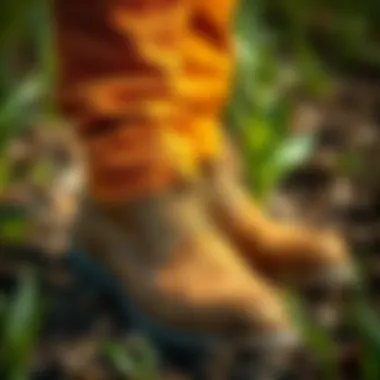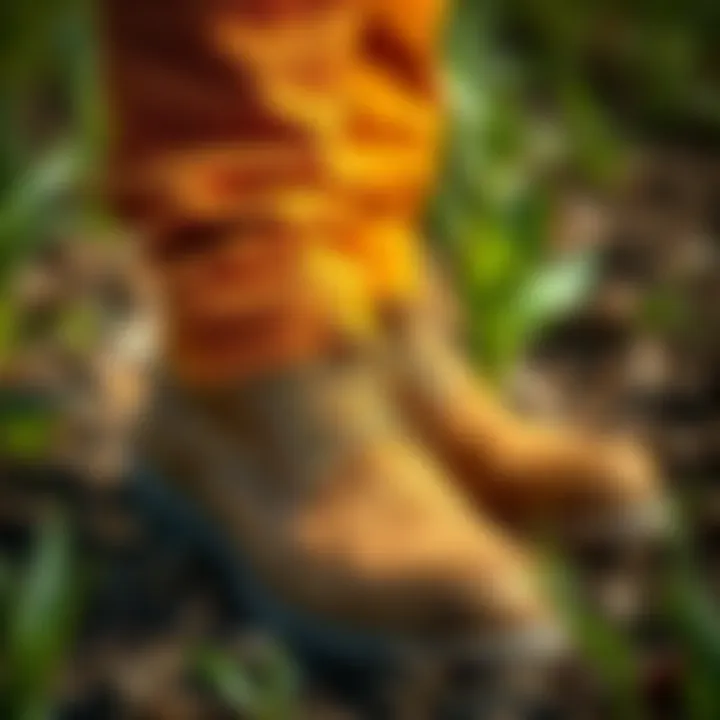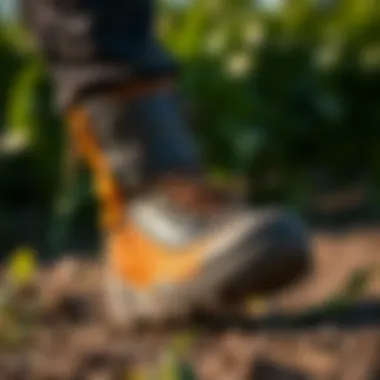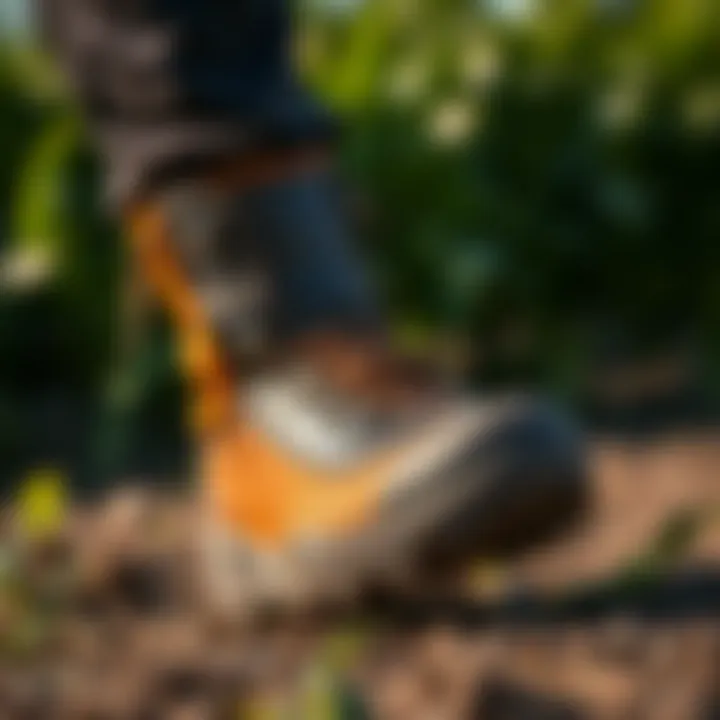Farm Footwear: Essential Solutions for Agriculture


Intro
In the world of agriculture, every detail counts, from the seeds you sow to the tools you wield. One often overlooked, but equally crucial detail, is the footwear that farmers don as they tend to their crops or care for livestock. Proper footwear is not just a matter of personal style or comfort; it has significant implications for safety, efficiency, and even health in the farming environment. The correct footwear protects against various elements encountered daily on the farm—from mud and manure to sharp objects and slippery surfaces.
As the agricultural landscape evolves, so too does the technology and design of farming footwear. Innovations geared toward sustainability and comfort have emerged, addressing the modern farmer’s needs—or hobbies—more effectively than ever before. This article will take a comprehensive look at the styles, materials, and technological advancements in farm footwear, with a focus on the tangible benefits these can provide.
Whether you are a seasoned farmer or an urban agriculture enthusiast, understanding the nuances of footwear in agriculture can enhance not only your safety but your overall productivity. Beyond just shoes, this discussion will also touch upon eco-friendly practices within the industry, highlighting products and practices that support both the farmer and the planet.
Understanding the Importance of Farm Footwear
Farm footwear is not just a matter of fashion; it plays a crucial role in protecting the health and safety of agricultural workers. The right footwear can mean the difference between a productive day in the field and a day marred by injury or discomfort. With the wide variety of conditions encountered in farming—from muddy fields to rocky terrain—having proper protective equipment for the feet becomes an essential consideration.
Proper farm footwear ensures that workers are safe from hazards such as sharp tools, heavy equipment, and slippery surfaces. Injuries in agriculture can be serious; therefore, safety should be at the forefront of every farmer's mind. Investing in solid, reliable footwear not only protects workers but can also lead to increased efficiency. After all, if workers are comfortable and protected, they can focus more on their tasks, resulting in better productivity and outcomes.
Safety Considerations for Agricultural Workers
Safety is paramount in any line of work, but the agricultural sector presents unique challenges. Farmers often work in environments where hazards lurk at every corner. For instance, muddy conditions can lead to slips and falls, while hard surfaces can cause fatigue and increase exposure to injuries.
- Protective Features: The right boots include a variety of protective elements such as steel-toe caps, puncture-resistant soles, and slip-resistant treads. These features serve as vital barriers against workplace injuries.
- Hazard Awareness: It’s crucial to evaluate the specific hazards present in different agricultural tasks. For example, working with livestock could expose a farmer to crush injuries. Therefore, heavy-duty boots that offer ankle support could be indispensable.
- Non-Slip Soles: Having footwear with good grip is vital for navigating wet or uneven ground. Boots designed with specialized tread patterns can significantly reduce the risk of slipping, especially when moving between fields or handling equipment.
Taking these safety considerations into account not only protects the worker but also contributes to the overall success of the farming operation. Remember, a safe worker is an efficient worker.
Comfort and Durability: Key Factors
Only durability matters if boots aren’t comfortable. Spending long hours on your feet demands footwear built for comfort over extended periods. A poor choice can lead to blisters, soreness, and fatigue, ultimately affecting productivity.
- Fit and Support: The fit is vital. Ill-fitting shoes can cause discomfort and injuries. Look for options that provide proper arch support and accommodate different foot shapes. Consideration of foot width is often overlooked; ensure you find a comfortable size.
- Breathability: Gladiators of the field? No one wants sweaty feet after a hard’s day work. Breathable materials help in keeping feet cool and dry, especially during hot summer months. Lightweight mesh panels can be beneficial here.
- Quality Construction: Durability cannot be overlooked. Farm footwear should withstand the punishing demands of agricultural work—from mud and water exposure to exposure against the elements. High-quality materials such as leather often provide better durability and can be worth the investment.
Good farm footwear combines safety, comfort, and durability, ensuring that agricultural workers remain effective and injury-free.
In essence, the importance of understanding farm footwear cannot be overstated. It's about making informed choices that align safety with practical needs, creating a solid foundation for productive farming. Regardless of the specific tasks at hand, suitable footwear contributes to a safer, more efficient working environment, which is essential for sustainable agricultural practices.
Types of Farm Footwear
In the diverse world of agriculture, choosing the right footwear isn't just about style; it's about functionality and safety. Different types of farm footwear serve distinct purposes, accommodating various tasks and environments that farmers find themselves in daily. Each category carries unique qualities tailored to tackle specific challenges faced in the field. Understanding these options is crucial for choosing the best fit for one's farming needs. The right footwear can enhance efficiency and lower the risk of injury, enabling farmers to focus on what truly matters—their work.
Boots: The Traditional Choice
Boots have long been the cornerstone of farm footwear. Known for their solid construction, they provide the durability needed for rugged terrains. Generally made from leather or rubber, boots offer excellent protection against sharp objects and heavy impacts—a common occurrence when navigating through fields. Moreover, their high tops shield the ankles, essential for avoiding sprains.
When selecting boots, one must consider slip resistance as muddy or wet conditions often make footing precarious. Thicker soles provide better cushioning, which lessens fatigue during long hours. Options like steel-toe boots give added safety in environments where heavy machinery is used.
"Investing in a good pair of work boots is like a farmer's best insurance policy against injury."
Shoes for Light Agricultural Tasks
For lighter agricultural tasks, such as planting or harvesting, shoes are a practical solution. These typically feature a lower profile compared to boots, allowing for greater mobility and comfort during less strenuous activities. Shoes made from breathable materials can significantly enhance moisture management and reduce sweat buildup, which is particularly beneficial during hot summer months.


Shoes also tend to be lighter in weight, which encourages ease of movement. However, when selecting shoes, consider the fit; a snug yet comfortable design ensures support while preventing blisters or chafing. Choosing styles with a firm grip is essential, particularly on uneven terrain.
Waterproof Options for Wet Conditions
Farmers frequently work under varying weather conditions, including rain, which can complicate daily tasks. Waterproof footwear options are essential for maintaining dry feet while doing things like irrigation management or livestock handling in the rain. These shoes or boots are equipped with specialized membranes that keep moisture out without trapping heat, ensuring comfort even in colder temperatures.
It's vital to look for options with sealed seams to prevent leaks effectively. Footwear like muck boots or galoshes can be particularly useful. Their rugged construction allows for slip resistance on muddy surfaces, which is crucial for maintaining balance and safety.
Specialized Footwear for Crop Production
In the realm of crop production, specialized footwear plays a remarkable role. Certain crops require farmers to be agile and quick on their feet, while others may need stability and support. For instance, when dealing with delicate seeds, specialized shoes designed with minimal tread can help minimize soil disruption during planting.
Some footwear options even feature reinforced toe caps for added protection against equipment while working in the fields. Additionally, certain brands offer footwear that is designed specifically to support various farming techniques, drastically improving overall efficiency and reducing strain on the feet during repetitive tasks.
Sandals and Breathable Footwear for Summer Work
As temperatures rise, breathable footwear options become indispensable. Sandals and shoes designed for ventilation allow air to flow freely, keeping your feet cool during long hours in the sun. They are especially practical for informal tasks or when tending to animals in warmer weather.
However, while comfort is a significant benefit, these options usually lack some protective features found in traditional work boots. Thus, farmers must weigh the pros and cons based on their specific tasks. Considerations include the potential hazards present, the surfaces worked on, and the nature of the tasks themselves.
Breathability remains essential; look for designs that allow for drainage and quick-drying materials. Having the right footwear for summer work can elevate comfort and reduce the risk of heat-related issues, allowing farmers to do their jobs effectively in sizzling conditions.
Choosing the Right Footwear for Your Needs
Selecting the right footwear for agricultural tasks is not just a matter of style; it can significantly impact safety, comfort, and efficiency on the farm. With the diverse range of tasks and environments in agriculture, the importance of choosing the appropriate footwear cannot be overstated. Getting this decision right ensures protection against various hazards, minimizes fatigue during long hours, and boosts overall productivity. Understanding your specific needs based on operational requirements, personal preferences, and budget constraints is essential.
Evaluating Work Environment Conditions
Every farm has its own unique challenges and conditions that can greatly influence footwear choices. For instance, you won’t want to don the same shoes in a muddy field as you would in a dry, rocky pasture. It’s important to assess the following aspects:
- Terrain: Rocky, uneven ground requires more robust footwear with better traction. In contrast, flat areas may allow for lighter shoes.
- Weather Conditions: If you’re working in a wet climate, waterproof boots or shoes are non-negotiable. Not only do they keep feet dry, but they also prevent moisture-related issues like fungal infections.
- Work Type: Different tasks, like livestock handling versus crop planting, demand different footwear features. A sturdy boot might be needed for animal handling, while lightweight shoes work for planting seeds.
By considering these factors, workers can make informed decisions regarding which type of footwear is best suited for their day-to-day tasks.
Understanding Personal Comfort Preferences
Comfort isn't just a nice-to-have; it's a necessity when it comes to footwear in agriculture. Nobody wants to get distracted by sore feet when keeping an eye on livestock or tending to crops. Here are a few critical points to consider:
- Fit: Shoes that grip too tightly or are too loose can lead to blisters or instability. It’s crucial to find footwear that fits well, possibly taking into account the type of socks you’ll wear.
- Support: Good arch support is essential for preventing long-term foot problems. A cushioned insole might also provide relief for those lengthy hours spent on one’s feet.
- Style: While practical considerations often take precedence, liking the look of your footwear can enhance your morale. Whether you prefer a rugged boot or sleek footwear, choosing something you feel good about can improve your work mindset.
Personal preference can dictate comfort levels, so take the time to try on different styles to see what works best.
Determining Budget Constraints
When making choices about farm footwear, budgetary considerations are naturally a key component. Here are some ideas on how to navigate this:
- Quality vs. Cost: Investing in a pair of boots might mean paying more upfront, but if they last several seasons longer than cheaper alternatives, what’s the true cost? Sometimes, the saying "you get what you pay for" rings painfully true in the footwear department.
- Sales and Discounts: Check local agricultural supply stores or online platforms that offer seasonal discounts on farm shoes. Planning your purchase ahead of time could lead to significant savings.
- Longevity: A more expensive pair of shoes or boots might save money in the long run due to fewer replacements required. Examine warranties or return policies offered by manufacturers, which can also create peace of mind.


Ultimately, understanding your financial constraints can help to zero in on the right footwear that bridges quality and value. Making informed footwear choices leads to better performance and satisfaction on the farm.
Footwear Materials: What You Should Know
When it comes to agricultural work, the materials that make up footwear play a critical role in determining their effectiveness. With a variety of tasks performed on the farm, from planting and harvesting to machinery maintenance, selecting the right materials can greatly impact not only comfort but also safety and durability.
Choosing the right material for farm footwear is just as essential as the style you pick. For instance, leather has long been a staple choice due to its robustness and ability to withstand wear and tear. In contrast, synthetic materials have come a long way, offering lightweight options that provide flexibility and often superior waterproofing. Understanding these materials will help you make informed decisions that align with your specific needs on the farm.
Leather vs. Synthetic Options
Leather offers an excellent blend of durability and longevity, making it a classic option for many farmers. Its natural properties allow for protection against abrasions while also offering some level of waterproofing, although full water resistance often requires additional treatments. However, leather can be heavy and may not always be the best choice for tasks involving consistent movement or long hours of wear.
On the flip side, synthetic footwear can be a game changer for many scenarios. Made from materials like nylon or polyester, these shoes are generally lighter and easier to clean.
Synthetic options can provide a high degree of customization in terms of fit and style, allowing farmers to select footwear that meets their personal comfort preferences.
They also often come equipped with advanced technologies, such as breathable membranes, which help manage moisture. Although they might not provide the same level of thermal insulation as leather, their quick-drying properties can be invaluable in wet conditions.
Waterproofing Technologies in Modern Footwear
The advancements in waterproofing technologies have transformed how agricultural footwear is designed. Traditional methods like rubber compromised breathability, whereas new technologies utilize specialized coatings and membranes that keep water out while letting moisture escape.
Common products like GORE-TEX or waterproof leather constructions are increasingly incorporated into farm shoes and boots, providing higher levels of comfort and protection simultaneously. This means that farmers can work in muddy fields or under unpredictable weather conditions without worrying about soggy socks or blisters.
Numerous brands are now focusing on these innovations, delivering footwear that not only stands up to the elements but is also lightweight and comfortable enough for all-day wear.
Breathability and Moisture Management
When working on a farm, breathability becomes a key concern, especially during the hot summer months. Poorly ventilated footwear can lead to discomfort and even skin irritations. Many modern farming shoes now feature breathable linings and mesh panels that allow for air circulation. This is crucial to managing moisture inside the shoe, creating a more comfortable environment for the feet.
Selecting footwear that incorporates moisture-wicking technologies can make a noticeable difference. They work by drawing sweat away from the skin, helping to regulate temperature and keep the feet dry. Farmers need to consider their specific work environments; lightweight, breathable materials can enhance performance during long hours of demanding tasks.
In summary, knowing the ins and outs of footwear materials equips agricultural workers with the necessary tools to choose wisely. Whether opting for time-tested leather or the innovative strides made in synthetic materials, understanding factors such as waterproofing and breathability will lead to better choices that promote both productivity and comfort on the farm. Make sure to invest time in finding the right pair of shoes that best suit your needs.
Footwear Innovation: Trends in Agricultural Footwear
The agricultural industry is constantly evolving, and just as farmers adapt their techniques, so too must their footwear. In an environment that demands resilience and performance, the innovation in farm footwear reflects broader trends toward sustainability and technological advancement. These innovations not only enhance the efficiency of agricultural tasks but also address concerns regarding comfort and safety for workers.
Choosing the right footwear sets the tone for a productive day in the field. As we delve into the trends shaping agricultural footwear, it becomes clear how these advancements can benefit farm workers in practical, everyday scenarios. The next sections will explore sustainable materials and technological innovations that are paving the way forward.
Sustainable Materials and Practices
The push towards sustainability in agriculture echoes across all facets of the industry, including footwear. As consumers become more aware of their environmental footprint, farmers are likewise seeking products that align with eco-friendly practices.
Innovative companies are now using materials such as recycled plastics and organic cotton, tapping into a cycle of sustainability. For instance, footwear crafted from recycled tires not only reduces waste but also provides substantial durability in rugged farming conditions.
Here are some notable highlights regarding sustainable practices in farm footwear:


- Recyclable components: Footwear brands have begun to offer shoes that can be fully recycled at the end of their lifespan, ensuring that every fabric component returns to the production cycle instead of ending up in a landfill.
- Plant-based materials: Using alternatives like hemp or bamboo allows footwear to biodegrade naturally, whereas conventional plastics may take hundreds of years to decompose.
- Local sourcing: Many brands are focusing on materials sourced within specific regions to minimize carbon emissions associated with transportation, supporting local growers and economies in the process.
With each step taken in sustainable farm footwear, agricultural workers can feel more in tune with their environment, making informed choices that benefit both their work and the planet.
Technological Advances in Performance
Stepping beyond material innovation, technological advancements in performance amplify the potential of agricultural footwear significantly. Today’s farmers encounter an array of challenging conditions that demand specialized solutions. From muddy fields to rocky terrains, performance-driven footwear helps workers meet these challenges head-on.
Some examples of cutting-edge features include:
- Enhanced traction systems: Many modern boots now incorporate specialized tread patterns and rubber compounds designed for grip, preventing slips and falls in hazardous environments.
- Shock absorption technologies: With improved insoles and cushioning systems, farmers experience reduced impact on their joints, which can translate to enhanced productivity during long hours.
- Climate adaptability: Footwear equipped with breathable and moisture-wicking properties helps to regulate temperature and keep feet dry, increasing comfort in fluctuating weather conditions.
Incorporating these technologies means workers can engage in their tasks with a level of comfort and safety that wasn’t previously achievable. The importance of innovative design cannot be overstated, as it directly ties into job satisfaction and physical well-being.
These advancements in farming footwear not only elevate everyday comfort but also enhance the overall functionality, making it easier for agricultural workers to perform under diverse and demanding conditions.
Footcare and Maintenance
Footcare and maintenance go hand-in-hand when it comes to preserving the longevity and functionality of farm footwear. For agricultural workers, wearing proper footwear is vital since they often face various risks and challenges in their environment. The right care can enhance safety, provide lasting comfort, and save on costs by prolonging the life of shoes and boots.
Cleaning and Care Tips for Farm Footwear
To keep farm footwear in good shape, regular cleaning and maintenance are essential. Different materials require different care, but here are some universal tips:
- Remove Mud and Debris: After a hard day of work, give your shoes the once-over. Use a stiff brush to scrub off any mud or dirt, especially from the soles and crevices. This not only keeps them looking presentable but also helps maintain traction and reduces wear.
- Use the Right Cleaner: Depending on the material you’re dealing with, use a specific cleaner. For leather, a damp cloth followed by a leather conditioner does wonders. For synthetic materials, a simple soap solution works just fine.
- Dry Properly: Never leave your footwear in direct sunlight or by a heater to dry as they can warp and lose shape. Instead, let them air dry in a cool, shaded area. If they're particularly damp, stuffing them with newspaper can help absorb moisture.
- Rotate Your Footwear: If possible, having a few pairs of farm shoes or boots can make a world of difference. Rotating your footwear allows each pair to dry out completely and can significantly reduce the accumulation of odor and bacteria.
Taking these simple steps can prolong the lifespan of your footwear and keep your feet feeling fresh and comfortable during your agricultural duties.
Signs of Wear: When to Replace Your Footwear
Knowing when to part ways with your trusty pair of shoes or boots can be the difference between a good day on the farm and a painful one. Here are signs that indicate it might be time for a replacement:
- Visible Damage: Look out for cracks in the sole, worn-down treads, or separation from the upper part of the footwear. These issues can jeopardize your safety by compromising traction and support.
- Loss of Cushioning: Over time, the cushioning inside footwear compresses. If you start feeling the ground more than you should while working, it’s a sign that the padding has seen better days.
- Uncomfortable Fit: If your shoes start to pinch or cause blisters, they may be past their prime. Comfort is key in farming work, and any discomfort should be noted as a serious red flag.
- Persistent Odor: Even with proper cleaning, sometimes footwear can accumulate an unpleasant smell. If you notice this despite all efforts to clean, it may indicate that the material has absorbed too much moisture over time.
In summary, being aware of these signs can help farmers make informed decisions about footwear replacement, ensuring they maintain optimal foot health and safety on the job. Regular checks for wear and proper maintenance will not only extend the life of your footwear but ultimately support better agricultural productivity.
End: The Role of Footwear in Sustainable Farming Practices
In the realm of agriculture, selecting the right footwear goes beyond mere comfort and protection. It can have significant implications for not just personal safety but also the broader specter of sustainable farming practices. This final section of our comprehensive resource takes a closer look at how footwear choices can align with sustainability goals, fostering a healthier environment for both workers and the land.
Sustainable farming emphasizes stewardship of the natural resources that agricultural practices depend on. Footwear plays a pivotal role in this equation through direct interactions with soil, water, and plant life. Choosing footwear made from sustainable materials, like organic cotton or recycled plastics, reduces the ecological footprint of farming operations. Additionally, when footwear is designed for durability and reparability, it further extends its life cycle, lessening waste.
Benefits of Thoughtful Footwear Choices
- Environmental Impact: Selecting boots and shoes that are sustainably sourced and manufactured can minimize the carbon footprint significantly. Recent advancements in sustainable technology have led to innovative materials that don’t compromise on performance.
- Worker Safety: Proper footwear protects farmers from injuries related to farm hazards. Better-designed footwear with features like slip resistance and sturdy soles not only keeps workers safe but fosters a culture of awareness about safety.
- Comfort During Long Hours: Comfortable footwear reduces fatigue, allowing workers to focus on their tasks rather than discomfort. This can have a ripple effect — better concentration leads to improved efficiency and productivity.
- Lifecycle Management: Investing in higher-quality footwear designed for longevity may require a higher initial cost, but the long-term savings on replacements can be substantial. Moreover, it fosters a mindset of mindful consumption.
"Walking a mile in the right shoes can leave a lighter footprint on the planet."
Encouraging Thoughtful Choices in Footwear
Encouraging farmers and agricultural workers to think critically about their footwear choices can lead to widespread benefits. Educational initiatives can promote awareness of sustainable options available in footwear designed explicitly for farming tasks. Workshops or on-site demonstrations can influence purchasing patterns.
In addition, farmers can engage in community discussions, leveraging platforms such as local farmer groups or online forums on Reddit, to share their experiences with sustainable footwear.
By advocating for products that prioritize ecological responsibility, farmers contribute to an agricultural landscape that nurtures both the land and its caretakers. It’s an ongoing path — every choice counts, and while we may walk different paths in our respective fields, choosing the right footwear can pave the way towards greater sustainability in the agricultural sector.







